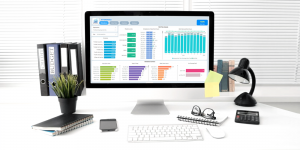The fact is 90% organizations don’t have proper Data Governance in place. Data Governance department or unit is to handle requirements from regulatory bodies but at the same time, data governance is also keeping balance between Data Asset and Liabilities.
Data governance framework creates a single set of rules and processes for collecting, storing, and using data. In details, it consists of the policies, rules, processes, organizational structures, and technologies that are put in place as part of a governance program throughout the organization.
It’s also considering as a set of principles and practices that ensure high quality through the complete lifecycle, it’s more to business rather than technology. To implement Data Governance in an organization, normally involves the following steps:
– Identify roles and responsibilities
– Define your data domains
– Establish data workflows
– Establish data controls
– Identify authoritative data sources
– Establish policies and standards
Without a robust Data Governance or information security measures within an organization, your business is at a higher risk of security incidents, such as data breaches, cyberattacks, or insider threats, which can result in financial losses, reputational damage, and legal repercussions.
To ensure the data governance that compliance to certain recognizable standards, organizations can incorporate ISO27001 international standard that specifies the requirements for an Information Security Management System (ISMS). Because an ISMS is a framework of policies, procedures, and controls that helps you protect your data from various risks and threats. How can you integrate ISO 27001 into your Data Governance program?
1. Assess your current data state
Before adopting ISO 27001, you can understand your current data landscape and identify the gaps and weaknesses in the data security practices by using data governance maturity model to evaluate your data capabilities and performance across different dimensions, such as data quality, data architecture, data governance roles, data policies, and data ethics. Or you can also conduct a risk assessment to identify the potential sources and impacts of data breaches, leaks, or losses.
2. Define your scope and objectives
The scope defines the boundaries of your ISMS, such as the data types, data sources, data processes, data stakeholders, and data systems that are covered by your ISMS. The objectives are to define the expected outcomes and benefits of your ISMS, such as the level of data protection, compliance, and trust that you want to achieve.
3. Implement your Information Security Management System (ISMS)
After defining your scope and objectives, you need to implement your ISMS according to the ISO 27001 requirements. This involves developing and documenting your data security policies, procedures, and controls that address the specific risks and challenges that you might encounter. You also need to assign roles and responsibilities for data security to your data governance team and other data stakeholders. Moreover, you need to establish mechanisms for monitoring, measuring, and reporting on your data security performance and compliance.
4. Certify and improve your ISMS
The final step is to certify and improve your ISMS. Certification is an optional but recommended process that involves an external audit by an accredited body that verifies that your ISMS meets the ISO 27001 standards. Certification can help you demonstrate your commitment and credibility to your customers, partners, regulators, and other stakeholders. Improvement is an ongoing process that involves reviewing and updating your ISMS based on the feedback, lessons learned, and best practices that you collect from your data security activities.
Data Governance for HR Analytics
Nowadays, organizations tend to subscribe applications from SaaS (Software as a Service) providers, the SaaS become the production plant for inputting raw data and generating meaningful data output. It is preferable that the solution provider provides extended DaaS (Data as a Service). It would be a plus point if the solution provider complies with ISO27001 certification to ensure data quality and data governance for the particular solutions, allowing you to focus on business value and organizational outcomes.
Subscribing to SaaS & DaaS and ensuring data governance compliance can mitigate the risk management and data breaches, which inherently core governance components. These compliances will cover the scope related to the applications that you have subscribed to, such as TimeTec HR Suite which related human resources department of an organization.
For your information, TimeTec has been ISO27001 certified organization since 2018 and enhanced with ISO 27017 and ISO 27018 in early 2024. The ISO 27017 certification demonstrates cloud service security to users, while the ISO 27018 certification ensures that personal data is processed securely, further boosting customers confidence. Additionally, 2-factor authentication can be implemented as option, and our yearly penetration test added as extra bonus for customers.
HR analytics is the collection and application of talent data is to improve critical talent and business outcomes. TimeTec HR Analytics enable business owners to develop data-driven insights of their talent pool, improve workforce processes and promote positive employee experience.
Instantaneous Data Crunching & Data Visualization to provide 360° on:
– Employee statistics and profiles
– Turnover & Retention Rate
– Salary and career path history
– Staff Performance
– Demographic data
– Attendance
– Absenteeism
– Leave pattern
– Claim pattern
The Benefits of TimeTec HR Analytics:
1. Improve talent acquisition
2. Increases talent retention
3. Prevent workplace misconduct
4. Increase productivity
5. Uncover skill gaps
6. Improve employee experience
7. Build highly engaged workplace
8. Reduce attrition rate
9. Machine learning spots the patterns that you might miss
Why TimeTec HR Analytics?
Strong Data Governance with ISO27001, ISO 27017 & ISO27018
• 2-Factor authentication & yearly Pentest for further data security
• Assurance of Data Quality
• Available Web & App visualization
• Affordable DaaS model, no setup cost
• Fast deployment with ready templates
• Detect HR anomalies fast and efficient
• Complete HR consolidation from all sources
• Extendable analytics to next activities for data enrichment
• Achieve data-driven HR strategy
• Prepare for the future: Smart HR + AI
Interested to find out more on TimeTec HR Suite and TimeTec HR Analytics, together its data governance compliances? Request your Free Demo of TimeTec HR solutions now.
03-8070 9933 | Email | www.timeteccloud.com | Interest Form


